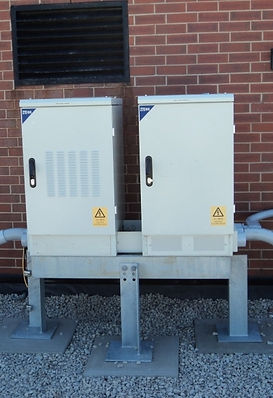

Equipment Support
In the Canadian telecommunications industry, equipment supports like play a crucial role in ensuring the stability, functionality, and safety of network infrastructure. These supports are essential for mounting, securing, and organizing equipment in various installation environments, from rooftops to tower sites.
Rogers and Bell Mobility frequently use RF ballast mount supports for rooftop installations in urban areas. These mounts are essential for deploying small cell sites to enhance network coverage. They also incorporate H-frames extensively for organizing and mounting 5G infrastructure on towers and rooftops. In suburban installations, they often pair wall-chairs with compact radio units to optimize space while maintaining service reliability.
These equipment supports are indispensable in enabling Canadian telecom giants like Rogers and Bell to deploy robust and efficient network infrastructure while adapting to diverse environmental and site-specific challenges.
Elements

Ballast Equipment Support with RF
These supports are crafted to mount equipment such as antennas onto surfaces without the need for penetration, commonly utilized in rooftop installations. The ballast system provides stability and prevents structural damage to the building.
Gord Telecom Inc. is a leader in producing RF ballast mount supports and other telecommunication infrastructure solutions. Their manufacturing process includes the design and fabrication of supports tailored to the unique demands of rooftop installations, conforming to industry standards of strength, durability, and resistance to weather.
The supports are meticulously engineered to distribute equipment loads evenly, guaranteeing stability without compromising the integrity of the rooftop structure.




Equipment Support Canopy
Equipment support canopies provide a protective structure for critical outdoor equipment such as radio units, power supplies, and cabinets. These canopies shield equipment from harsh weather conditions, including rain, snow, UV exposure, and debris, ensuring reliability and longevity for network infrastructure. They are essential in outdoor deployments, such as at base station sites or remote tower installations.
Depending on the site requirements, custom dimensions and configurations can be produced to accommodate specific equipment layouts. Canopies are designed for easy on-site assembly and integration with existing infrastructure, such as H-frames or ballast-mounted supports.

H-FRAME
Named for their "H" shape, these frames typically consist of two vertical supports connected by a horizontal crossbar or multiple cross-members. H-frames can be adjusted in height, width, and load capacity to support various telecommunications hardware, including antennas, cable trays, combiners, or HVAC units.
H-frames are versatile equipment supports used in the telecommunications industry to securely mount and organize critical infrastructure, such as antennas, cable trays, conduits, HVAC units, and radio equipment. These modular frames are often deployed on rooftops, ground sites, or inside facilities, providing a stable platform for telecom hardware. They are particularly valued for their adaptability, load-bearing capacity, and ease of installation.

Light Equipment Platform
A light equipment platform (LEP) is a structural support system designed to house and elevate lightweight telecommunications equipment, such as small antennas, remote radio units (RRUs), and associated hardware. These platforms are typically used in rooftop or tower applications and are engineered to provide stability, protect the equipment, and optimize space utilization. They are ideal for urban environments where compact and discreet setups are essential.
LEPs are less expensive to fabricate and install compared to heavy-duty platforms or larger structural reinforcements. They are highly adaptable, suitable for both rooftop and tower applications, and compatible with a range of telecom hardware. Non-penetrative installation options make them ideal for leased rooftops, ensuring no permanent alterations are required.

Roof Equipment Support
Roof equipment supports are structural systems designed to mount and stabilize telecommunications equipment on rooftops. These supports ensure the safe and secure deployment of antennas, cable trays, HVAC units, conduits, and other telecom hardware while protecting the building's structural integrity. They play a crucial role in rooftop installations, which are common in urban areas where space is limited and towers may not be feasible. They are designed to distribute weight evenly across the rooftop, preventing localized stress or damage to the building structure.





Tower Fencing
Tower fencing serves as a protective barrier and support system for telecommunications infrastructure, particularly around tower sites. While its primary purpose is to enhance security and safety, it also functions as an indirect form of equipment support by safeguarding ground-level telecom assets, such as base station cabinets, power systems, and auxiliary equipment.
By leveraging years of experience and a commitment to quality, Gord Telecom has developed fencing solutions tailored to meet the unique demands of telecom sites, ensuring both safety and operational efficiency.

Wall Chair
A wall chair is a structural bracket or support system used in the telecommunications industry to mount equipment, such as antennas, cables, and other hardware, directly onto vertical surfaces like walls or masts. Wall chairs are essential for ensuring secure and efficient installation of telecom infrastructure in areas where space is limited or where ground or rooftop mounting is not feasible.
It is typically constructed with a sturdy metal frame that securely attaches to walls or vertical poles. A wall chair includes mounting brackets, arms, or adjustable supports for positioning telecom equipment at the desired angle and orientation.
